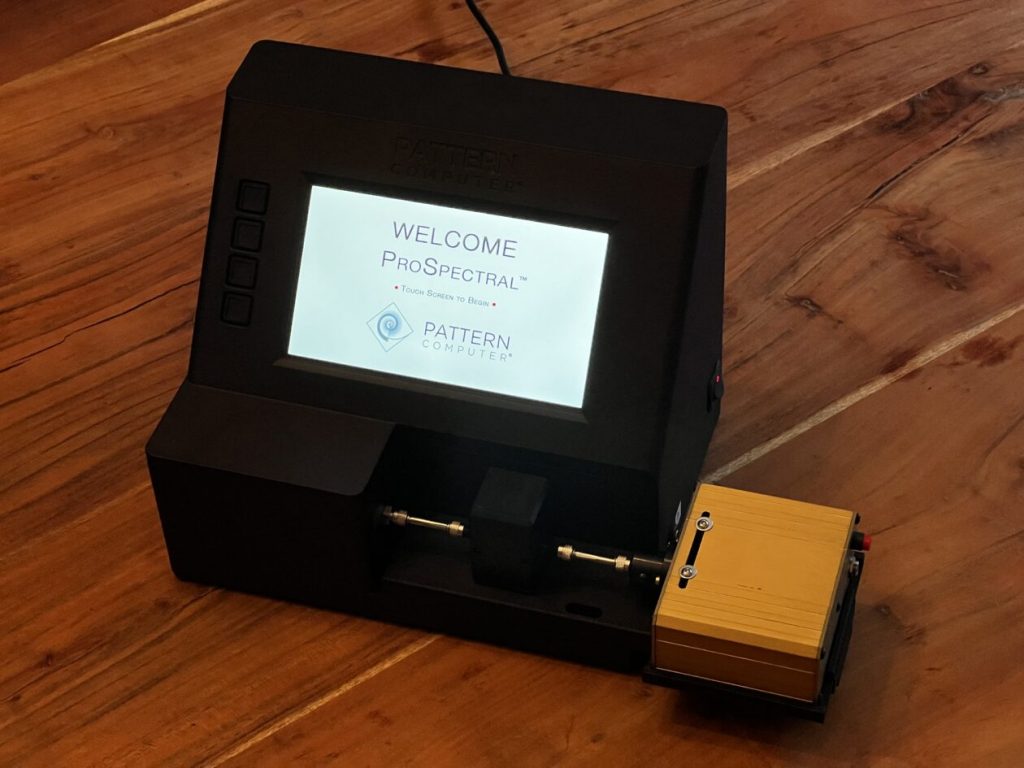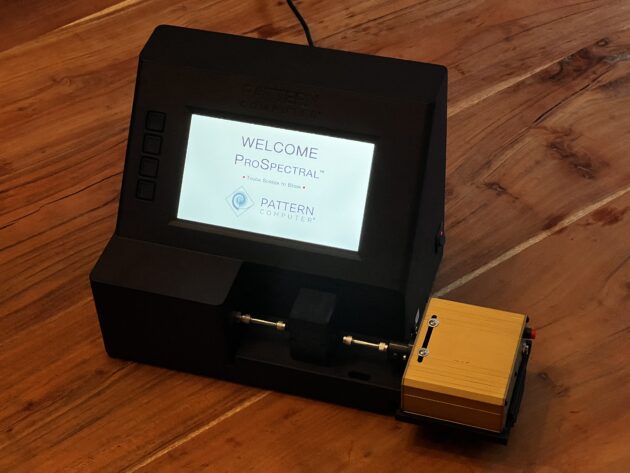
A Seattle-area startup called Pattern Computer is developing a rapid COVID-19 test based on patterns in light from spit, one of several projects moving ahead from the 7-year-old company that designed its own computer from scratch.
The company’s “Pattern Discovery Engine” was created specifically to discover and analyze patterns and excels at the task, said CEO and co-founder Mark Anderson.

Pattern Computer keeps the workings of its system closely guarded, and has not published its AI models in peer-reviewed journals. Outside researchers say it’s hard to know what’s under the hood.
But its approach has attracted seasoned computer science talent and biotech heavyweights to the startup.
The company’s chief technology officer, co-founder Ty Carlson, previously managed the Amazon team that launched products such as the Amazon Echo. Its advisory board includes Leroy Hood, a co-founder of the Institute for Systems Biology, genome pioneer Craig Venter, and serial biotech startup founder George Church, a Harvard professor.
Anderson is founder and CEO of technology newsletter Strategic News Service, read by Bill Gates, Jeff Bezos, Michael Dell and Elon Musk, he said. Anderson’s known as a “tech prognosticator” and each year brings together an eclectic mix of tech leaders and scientists at his “Future in Review” conference (he also co-founded the Whale Museum in Friday Harbor, Wash., where he lives).
At his 2015 conference, Anderson hosted a “chief technology officer challenge,” where participants designed a desktop supercomputer. The resulting system formed the seed for Pattern Computer. Participants included the other company co-founders, entrepreneur Brad Holtz and Michael Riddle, who previously co-founded Autodesk, makers of AutoCAD and other industrial software.
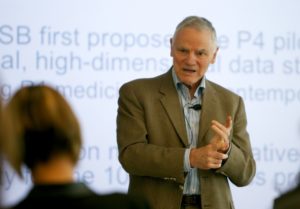
Pattern Computer focuses on biomedicine. But it also addresses problems in materials design, veterinary medicine, finance, mathematics, and aerospace with its partners, such as an analysis of ways to reduce flight delays.
Pattern Computer has raised $26 million to date, all from individual investors, including Venter and Ken Goldman, former chief financial officer of Yahoo and Pattern’s consulting CFO. The startup is now seeking to raise $40 million with a valuation of $1.2 billion, said Anderson.
“It’s a company that is taking an intriguing new approach to manipulate and analyze big data,” said Hood. And when the pandemic hit, it “thought deeply about the COVID problem,” said Hood.
Gearing up a spit test
Pattern Computer takes a unique approach to COVID-19 testing. The company analyzes patterns of light that pass through and are absorbed by spit.
The test takes only two drops of saliva and reads off a result from the company’s “ProSpectral” device within three seconds. The device harnesses an approach called hyperspectral sensing, which involves the analysis of light across all spectrums.
Instead of measuring the virus directly, the test captures the jumbled immune and metabolic response to disease. “There’s a fingerprint for that in light,” said Anderson.
Company researchers trained and assessed their model using spit from 470 samples roughly equally divided between those that were COVID-19 positive and negative on a PCR test, a conventional way to detect the disease.
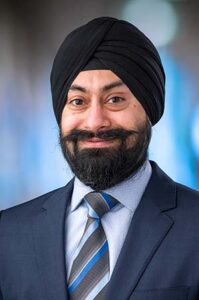
Pattern’s test could detect 100% of people with the disease, with 8% of individuals without the disease showing a false-positive result, Anderson reported at the Life Sciences Innovation Northwest meeting this April. Shifting the test’s parameters enabled some COVID-19 cases to slip through undetected but yielded fewer false-positive results.
The test is also inexpensive: the in-house cost of running it is about 50 cents.
The testing approach is “very smart,” said Taran Gujral, a systems biologist and associate professor at Fred Hutchinson Cancer Center. Gujral, who does not have a financial or collaboration relationship with the company, said the method also holds promise for detecting other diseases, potentially enabling rapid testing in airports, hospitals, and in the field.
“We think it will change diagnostics,” said Anderson.

Keeping company secrets
Other outside researchers said they need more information to assess the company’s approach to COVID-19 testing.
The company does not divulge whether it captures data using a standard type of spectrophotometer that measures light in biological samples, or another instrument. “They are not sharing any information on how the signal is generated,” said Dan Fu, an assistant professor of chemistry at the University of Washington.
University of Washington microbiology professor Evgeni Sokurenko, who is developing a rapid test for COVID-19 variants as co-founder of ID Genomics, said it’s important to look closely at Pattern Computer’s data — in particular, the PCR data it used to train and test its models.
PCR tests work by replicating DNA derived from the virus through multiple cycles to detect a signal. Different labs use different cycle numbers for COVID-19 testing, he said. Higher cycle numbers detect lower levels of virus.
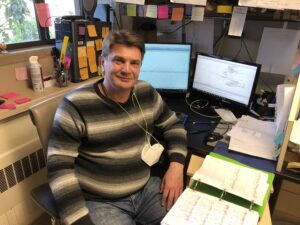
The majority of Pattern Computer’s COVID-19 positive samples had a cycle threshold below 30, said company researcher Matt Keener — whereas the typical threshold is set higher, said Sokurenko (at 35-40 cycles).
That raises the possibility that the company’s models may not be geared to pick up low levels of the virus, and could therefore miss some asymptomatic infections, said Sokurenko.
Keener countered that the company’s data are consistent across all PCR thresholds. The results “don’t show any statistical sensitivity to the PCR value,” said Keener. “Our accuracy holds no matter what the PCR value for an individual test sample is.” In addition, the accuracy of the company’s test held true whether the samples came from asymptomatic or symptomatic individuals, he said.
The U.S. Food and Drug Administration will be the final judge of the company’s COVID-19 test.
Pattern Computer has applied to the agency for emergency use authorization. It’s also identified four other countries for potential launch and has arranged for partners to help it scale up and produce the test.
“We’re looking forward to being able to discuss more once we are comfortably down the road to regulatory approvals and such,” said Keener.
Pattern Computer’s other bioscience projects include mining databases on gene activity in cancer cells to identify potential treatments, based on drugs already approved for other diseases — though it’s hard to tell how the company’s approach to this and other data-mining problems compares to others, said Gujral, who does similar research.
The company has identified two drug combinations that kill breast cancer cell lines in culture, and is moving them through animal testing for hard-to-treat “triple-negative” tumors. It also is investigating treatments for ovarian cancer and other tumor types.
Speaking at an investor presentation earlier this year, Omid Moghadam, CEO of diagnostics startup Namida Lab, said Pattern’s discovery engine substantially increased the predictive accuracy of an experimental test for breast cancer based on tear samples. Moghadam is a Pattern Computer customer and advisor.
Another project involved predicting clinical outcomes in patients infected with various adenovirus variants that lead to conjunctivitis (pink eye), though the outlines of the model were not disclosed in the resulting publication.
“Their first priority has been to get everything going, which they’ve really had to put an enormous amount of time into,” said Hood. “I suspect they will be publishing comparative papers in the future.”
The team has been refining its system and mathematical tools over the last several years, with a lean crew of 21 employees. “We’ve been very heads down,” said Anderson.
Next generation computing
Pattern Computer is following the path of other groups, from academic labs to tech companies like Alphabet, that are changing how computers are constructed and programmed. The advent of artificial intelligence is spurring a surge of innovation.
AI models need to process vast numbers of calculations simultaneously. And current computing architecture designs are becoming a bottleneck for “computing speed, infrastructure cost, and power consumption,” said University of Chicago assistant professor of molecular engineering Sihong Wang.
“People working on the hardware side have started to develop a completely different type of computing platform that processes information by emulating the operation of neurons in the brain,” said Wang, who recently developed a flexible computing chip for wearable health tech, and is not familiar with Pattern Computer’s system.
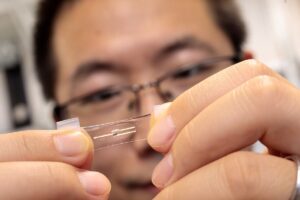
Anderson said Pattern Computer’s approach is unique. The company created an AI system that is distinct from the neural network approached leveraged by others, he said. “This is qualitatively very different from where someone has a neural network and they’re pushing it and modifying it,” he said.
Pattern Computer’s “explainable AI” enables it to counteract bias that can be baked into more conventional machine learning models by skewed training datasets, said Anderson.
“It allows us to see how and why the system was successful in getting high prediction rates,” he said. “Knowing how and why the system works provides the type of knowledge required to make major pattern discoveries, improve research, and solve real business problems.”
Building that new way to make sense of patterns is “a challenging problem,” said Neeraj Kumar, a senior data scientist at Pacific Northwest National Laboratory.
In a recent preprint with outside researchers, company researchers published their view of how explainable AI could be applied to health data.
The publication does not specify how the company’s system works, said Vijay Janapa Reddi, a Harvard associate professor who directs the university’s Edge Computing Lab. “It is hard to glean much” about the startup from the preprint, said Reddi, who was not familiar with the company.
But Kumar has seen enough to be convinced.
“Pattern Computer’s computational approach is very robust,” said Kumar, an author on the paper. And it is “the first step for developing an explainable AI by extracting novel patterns in complex data that cannot be discovered using conventional analytical techniques and algorithms,” he said.
Meanwhile, the company is turning its attention to securing regulatory approval for its COVID-19 test and planning for scale up.
“We’ve created a different kind of company,” said Anderson. “We’ve done it in a different way.”
Editor’s note: This story has been updated to include information on a conjunctivitis project.

